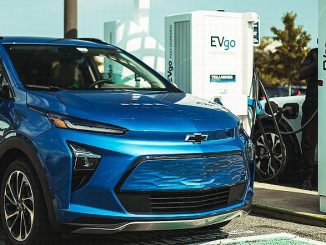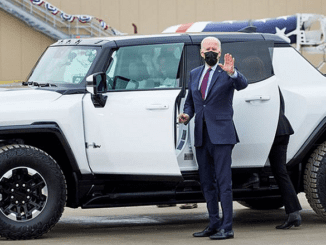
WILMINGTON, Delaware, August 14, 2020 (ENS) – In their first campaign appearance together as running mates, Joe Biden, the presumptive Democratic Party nominee for President, and his newly announced vice presidential choice, Senator Kamala Harris, both mentioned their climate plan.
Speaking from a nearly empty school gym to prevent the spread of the coronavirus, Biden told the viewing audience watching the historic event onscreen, “We have a climate crisis that Donald Trump refuses to even acknowledge.”

“When he thinks about climate change, all he hears is one word: ‘hoax,’ Biden accused his rival.
“The Biden-Harris Administration is going to meet the climate crisis, protect the health of the American public, and along the way, we’re going to deliver one word: jobs. Good paying jobs,” said Biden, who served as vice president with President Barack Obama during both his terms.
In a separate speech, Senator Harris, who represents California, put fighting climate change at the top of her list of priorities. “Let’s be clear,” she said. “This election isn’t just about defeating Donald Trump or Mike Pence. It’s about building this country back better. And that’s exactly what Joe and I will do. We’ll create millions of jobs and fight climate change through a clean energy revolution, bring back critical supply chains so the future is made in America, build on the Affordable Care Act.”
Two weeks ago, Harris, the first Black woman to be nominated for vice president by a major political party, emphasized her commitment to communities of color impacted by climate change by introducing climate equity legislation together with Green New Deal advocate Representative Alexandria Ocasio-Cortez, a New York Democrat.
Their Climate Equity Act is a draft legislative proposal to ensure that the United States government makes communities on the frontlines of the climate crisis the foundation of policy related to climate and the environment, including the policies to build a Green New Deal.
Over the past year, the California senator has been working with the New York congresswoman in offering the opportunity to shape this bill to the climate-concerned community that she and Biden hope to attract.
As the two senators introduced the bill on July 29, Harris said, “We need a Green New Deal based in climate and environmental justice, which means building a clean economy that protects communities that have been neglected by policymakers for far too long. I’m proud to work with Congresswoman Ocasio-Cortez on this comprehensive proposal, and I’m hopeful that it brings a Green New Deal closer to reality.”
Their bill would create an Office of Climate and Environmental Justice Accountability within the White House Office of Management and Budget and require the government to consider the impact of any environmental legislation or regulation on low-income communities.
Then, Harris advocated for the federal government to take legal action against fossil fuel companies for their legacy of climate pollution, during her presidential run.
What’s In the Plan?
In July, before he had selected a running mate, Biden announced his plan to invest $2 trillion over four years in clean energy and environmental justice. Now the Biden-Harris plan, the proposal is getting more attention as the Democratic Nominating Convention approaches next week in Milwaukee, Wisconsin.
Due to the pandemic, most of the convention will be held remotely from many venues across the country. While being a largely virtual convention, it will be officially based at the Wisconsin Center, where it will be gaveled in and out each night.
Watch parties are planned around the country, some hosted by political leaders such as Amy Klobuchar, the senior United States senator from Minnesota and former Democratic president hopeful.
On the climate crisis, Biden’s basic attitude is that wherever we live – city or country, “climate change poses an existential threat – not just to our environment, but to our health, our communities, our national security, and our economic well-being,” he explains on the Biden for President website.
“It also damages our communities with storms that wreak havoc on our towns and cities and our homes and schools. It puts our national security at risk by leading to regional instability that will require U.S military-supported relief activities and could make areas more vulnerable to terrorist activities,” the plan recognizes.

Biden believes the Green New Deal is “a crucial framework for meeting the climate challenges we face.”
The Clean Energy and Environmental Justice Plan aims to:
* – Ensure the U.S. achieves a 100% clean energy economy and reaches net-zero emissions no later than 2050.
* – Rally the rest of the world to meet the threat of climate change.
* – Stand up to the abuse of power by polluters who disproportionately harm communities of color and low-income communities.
* – Biden’s climate and environmental justice proposal will make a federal investment of $1.7 trillion over the next ten years, leveraging additional private sector and state and local investments to total to more than $5 trillion.
* – Biden’s Day One Unprecedented Executive Actions to Drive Historic Progress
On day one, Biden will use the full authority of the executive branch to reduce emissions by:
* – Requiring aggressive methane pollution limits for new and existing oil and gas operations.
* – Using the Federal government procurement system – which spends $500 billion every year – to drive towards 100% clean energy and zero-emissions vehicles.
* – Ensuring that all U.S. government installations, buildings, and facilities are more efficient and climate-ready, harnessing the purchasing power and supply chains to drive innovation.
* – Reducing greenhouse gas emissions from transportation – the fastest-growing source of U.S. climate pollution – by preserving and implementing the existing Clean Air Act, and developing rigorous new fuel economy standards aimed at ensuring 100% of new sales for light- and medium-duty vehicles will be electrified and annual improvements for heavy-duty vehicles.
* – Doubling down on the liquid fuels of the future, which make agriculture a key part of the solution to climate change. Advanced biofuels are now closer than ever as we begin to build the first plants for biofuels, creating jobs and new solutions to reduce emissions in planes, ocean-going vessels, and more.
* – Saving consumers money and reduce emissions through new, aggressive appliance- and building efficiency standards.
* – Committing that every federal infrastructure investment should reduce climate pollution, and require any federal permitting decision to consider the effects of greenhouse gas emissions and climate change.
* – Requiring public companies to disclose climate risks and the greenhouse gas emissions in their operations and supply chains.
* – Protecting biodiversity, slowing extinction rates and helping leverage natural climate solutions by conserving 30% of America’s lands and waters by 2030.
* – Protecting America’s natural treasures by permanently protecting the Arctic National Wildlife Refuge and other areas impacted by President Trump’s attack on federal lands and waters, establishing national parks and monuments that reflect America’s natural heritage, banning new oil and gas permitting on public lands and waters, modifying royalties to account for climate costs, and establishing targeted programs to enhance reforestation and develop renewables on federal lands and waters with the goal of doubling offshore wind by 2030.
* – Bringing together America’s top talent to innovate on climate. America – with the leadership of government – has led the way on many technologies and innovations, from GPS to computer networking. Biden will establish ARPA-C, a new, cross-agency Advanced Research Projects Agency focused on climate.
* – Accelerating the deployment of electric vehicles by building charging stations for at least 500,000 new public charging outlets by the end of 2030. Biden pledges to restore the full electric vehicle tax credit to incentivize the purchase of electric vehicles.
In this plan, Biden pledges to re-enter the Paris Agreement on day one of the Biden Administration and lead a major diplomatic push to raise the ambitions of other countries’ climate targets. Trump has put the world on notice that he intends to take the United States out of the Paris Agreement to volluntarily regulate greenhouse gas emissions.
“The Paris Agreement was a historic breakthrough for the world and reflected the power of patient, strategic diplomacy in service of America’s long-term national interests,” the Biden campaign states.
Biden was there as vice president alongside President Barack Obama to rally the world to get to Paris; and, if he is elected, says he will be prepared on day one to take it to the next level. To catalyze this effort, Biden will, in his first 100 days in office:
* – Convene a climate world summit to directly engage the leaders of the major carbon-emitting nations of the world to persuade them to join the United States in making more ambitious national pledges, above and beyond the commitments they have already made.
* – Lead the world to lock in enforceable international agreements to reduce emissions in global shipping and aviation.
* – Embrace the Kigali Amendment to the Montreal Protocol, adding momentum to curbing hydrofluorocarbons, an especially potent greenhouse gas, which could deliver a 0.5 degree Celsius reduction in global warming by mid-century.
* – Pursue strong new measures to stop other countries from cheating on their climate commitments.
“If we can harness all of our energy and talents, and unmatchable American innovation,” says Biden, “we can turn this threat into an opportunity to revitalize the U.S. energy sector and boost growth economy-wide. We can create new industries that reinvigorate our manufacturing and create high-quality, middle-class jobs in cities and towns across the United States. We can lead America to become the world’s clean energy superpower.”
Copyright Environment News Service (ENS) 2020. All rights reserved.



